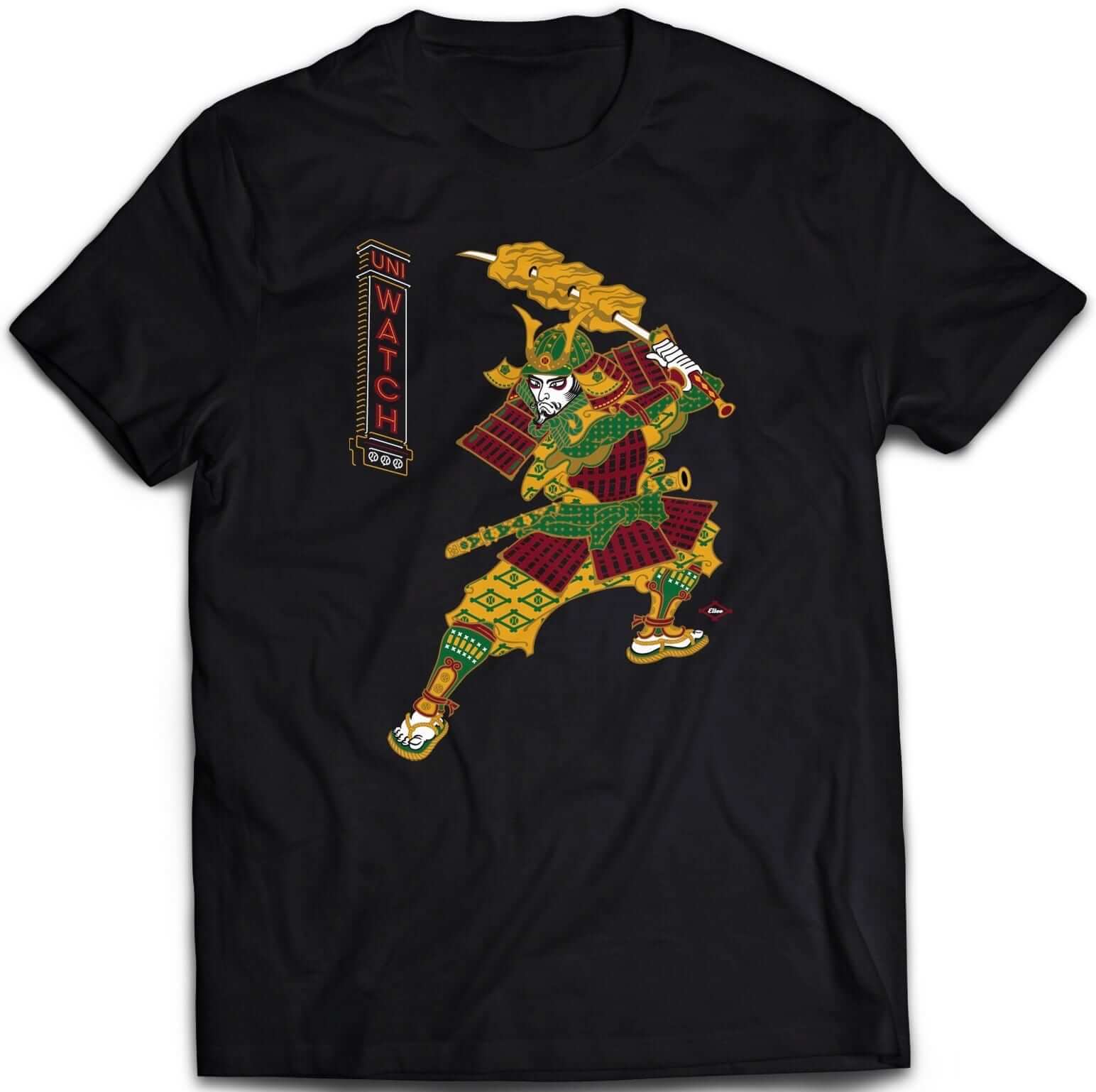
Several people have raised questions about the latest Uni Watch T-shirt design (shown at right; click to enlarge). The shirt, created by designer/illustrator Larry Torrez, shows the mascot for a fictitious Japanese baseball team, the Kyoto Yakitori. The mascot is a samurai warrior whose sword/bat also serves as a skewer for cubes of grilled chicken (a common Japanese dish called yakitori). The neon sign was inspired by the signs commonly used by yakitori restaurants in Japan.
Several Uni Watch readers have asked, “If you’re opposed to sports teams using Native American imagery, why are you okay with this design? Isn’t this the same kind of cultural misappropriation you typically argue against?”
It’s a fair question, and one that I thought about as Larry and I worked on the design. I ultimately decided that the shirt is fine. Here’s why:
1. It seems to me that samurais, who existed centuries ago, long ago crossed over from being a Japanese thing to simply being a pop-cultural thing. That’s why we have samurai movies, samurai comic books (including cat-themed samurai comic books), samurai video games, samurai action figures, and so on, almost all of which are made by non-Japanese artists/producers/etc. And just to give all of this a Uni Watch connection, there’s even a British uniform manufacturer called Samurai Sport.
Here’s a useful comparison: Ninjas, like samurais, are warriors from Japanese history who long ago crossed over into the pop cultural realm. Do you think Teenage Mutant Ninja Turtles are a form of cultural misappropriation? If you think they are, that’s certainly your prerogative, but I respectfully disagree. I’d say TMNT playfully mixes cultural elements to form an entertaining parody. And I’d say our Kyoto Yakitori shirt design does the same thing.
2. The shirt is obviously done in the ukiyo-e graphic style. This too strikes me as something that long ago crossed over into the realm of vernacular pop culture, where graphic arts style are borrowed, blended, mixed, matched, and so on. What if Larry had done a shirt in the style of Russian Constructivism, or French Impressionism, or any number of other visual styles associated with certain cultures — would that have been cultural misappropriation? Of course not, because artists borrow each other’s styles all the time, often in a very obvious wink-wink way. Larry’s design, which is clearly a ukiyo-e parody, falls squarely in that tradition.
3. Larry’s depiction, with the samurai’s sword serving as a baseball bat and as a kebab skewer, is so obviously silly (in the best way) that the whole design clearly falls into the realm of parody.
4. When discussing Native American iconography, I’ve usually tried to distinguish between appropriation and misappropriation. To see what I mean, consider two other aspects of this shirt design: Japanese baseball and neon signage. Japanese baseball could be considered a form a cultural appropriation (“Hey, they stole our national pastime!”) and neon signs were popularized in France before they began popping up elsewhere. Is there anything wrong with either those things? Of course not. That’s the difference between appropriation and misappropriation.
I think this shirt falls on the right side of that line. If you disagree and don’t like the shirt for this reason, and/or if you think I’m being intellectual inconsistent here, that’s fine. It’s all good food for thought, and I’ve enjoyed delving into this issue. Thanks for the feedback.